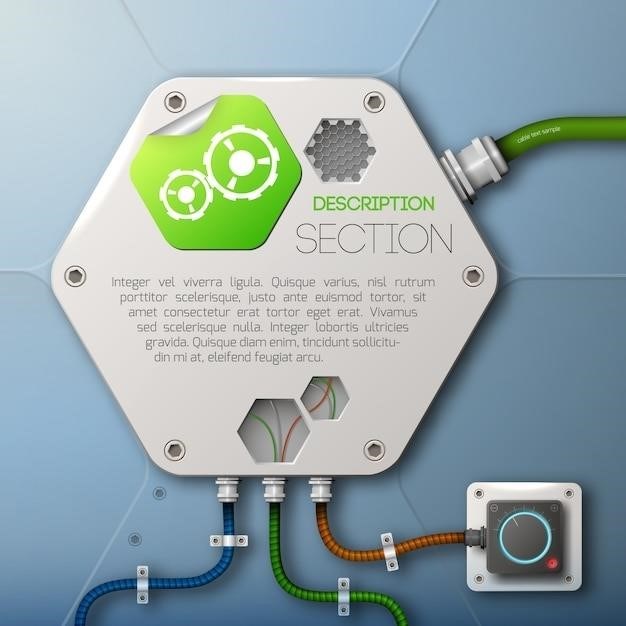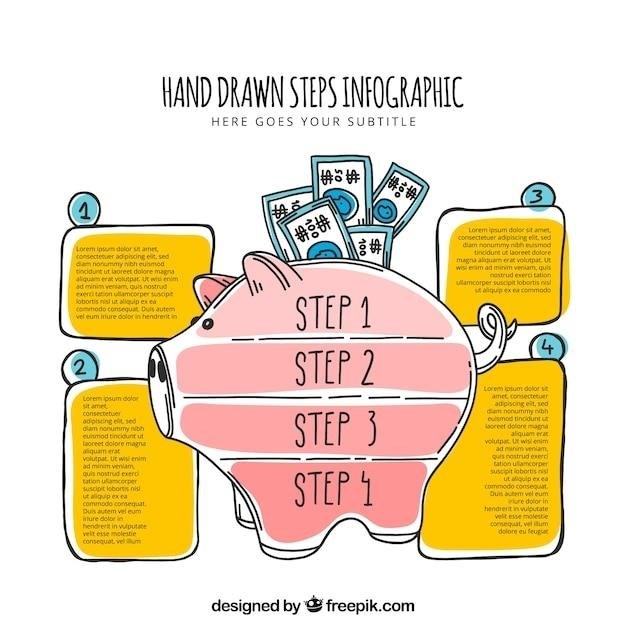LG LFXS26973S Manual⁚ A Comprehensive Guide
This manual provides a detailed guide to the LG LFXS26973S refrigerator‚ covering everything from installation to troubleshooting. Explore the product overview‚ key features‚ smart functions‚ and maintenance tips. Find essential information about the warranty‚ where to locate the manual‚ and more. This comprehensive guide will equip you with all the necessary knowledge to effectively use and maintain your LG LFXS26973S refrigerator.

Introduction
Welcome to the comprehensive guide for the LG LFXS26973S refrigerator. This manual is your essential companion to understanding and maximizing the features and functionality of your new appliance. The LG LFXS26973S is a smart French door refrigerator designed to elevate your kitchen experience with its advanced technology and spacious storage solutions. This manual covers everything from unpacking and installation to using the various smart functions and maintaining your refrigerator for optimal performance.
Whether you’re a seasoned chef or a casual cook‚ this guide will help you navigate the intricacies of the LG LFXS26973S. It provides detailed instructions‚ helpful tips‚ and troubleshooting advice to ensure you get the most out of your refrigerator. With this manual‚ you’ll be able to keep your food fresh‚ organized‚ and easily accessible‚ while enjoying the convenience and innovation that LG is known for.
Take your time to explore the content within this manual. It’s designed to empower you with the knowledge and confidence to confidently operate and maintain your LG LFXS26973S refrigerator for years to come. Feel free to refer back to this manual whenever you have questions or need to refresh your understanding of specific features or functions.
Product Overview
The LG LFXS26973S is a 26.2 cubic foot French door refrigerator with a sleek and modern design that complements any kitchen decor. Its spacious interior offers ample room for storing a variety of food items and beverages‚ making it ideal for families or those who enjoy entertaining. The refrigerator boasts a host of innovative features designed to enhance freshness‚ convenience‚ and energy efficiency.
The LG LFXS26973S is equipped with dual ice makers‚ ensuring you’ll never run out of ice for your drinks or cocktails. This feature eliminates the need for bulky ice trays and provides continuous ice production. The SpacePlus Ice System allows you to maximize storage space in the freezer compartment by using a slimmer ice maker design.
The refrigerator also features a water and ice dispenser‚ offering easy access to chilled water and ice cubes. This is a convenient addition for busy households‚ allowing you to quickly quench your thirst or add ice to your drinks without having to open the refrigerator door. The LG LFXS26973S is ENERGY STAR certified‚ indicating its energy efficiency and commitment to sustainability.
Key Features
The LG LFXS26973S is packed with innovative features that enhance convenience‚ freshness‚ and energy efficiency. These key features contribute to a superior refrigerator experience⁚
- Smart Cooling Plus⁚ This technology maintains optimal humidity and temperature levels throughout the refrigerator‚ ensuring that your food stays fresh for longer. It also helps to prevent freezer burn by controlling the humidity levels in the freezer compartment.
- Dual Ice Makers⁚ With two ice makers‚ you’ll never run out of ice. One is located in the freezer compartment‚ while the other is a door-in-door ice maker‚ providing convenient access to ice without opening the entire refrigerator door.
- SpacePlus Ice System⁚ This feature uses a slimmer ice maker design‚ freeing up valuable space in the freezer compartment. This allows you to store more food items and maximize the refrigerator’s storage capacity.
- Door-in-Door⁚ This innovative design provides quick access to frequently-used items without opening the entire refrigerator door. It helps to maintain cold air inside the refrigerator and prevents temperature fluctuations.
- GlideNServe Shelves⁚ These shelves are designed to slide out smoothly‚ allowing you to easily access items stored in the back of the refrigerator. The shelves are also adjustable to accommodate different sizes of food containers.
- PrintProof™ Stainless Steel⁚ The refrigerator’s exterior is made of fingerprint-resistant stainless steel‚ making it easy to clean and maintain. This feature helps to keep the refrigerator looking its best‚ even with frequent use.
- LG ThinQ App⁚ This app allows you to remotely monitor and control your refrigerator from your smartphone or tablet. You can adjust temperature settings‚ manage ice production‚ and receive notifications about potential issues.
Installation Guide
The LG LFXS26973S refrigerator installation process is straightforward but requires careful attention to ensure proper operation and safety. Follow these steps for a successful installation⁚
- Unpacking⁚ Carefully unpack the refrigerator‚ removing all packing materials and accessories. Ensure that the refrigerator is free of any damage.
- Location Selection⁚ Choose a suitable location for the refrigerator‚ ensuring it is level and has adequate clearance for ventilation. The refrigerator should be placed away from direct sunlight or heat sources.
- Water Line Connection⁚ Connect the water line to the refrigerator’s water inlet valve. Ensure the water supply is cold and the water pressure is within the recommended range (20-120 psi).
- Leveling⁚ Use the adjustable leveling feet to ensure the refrigerator is level. This will prevent the refrigerator from tipping over and ensure proper operation.
- Door Alignment⁚ Align the doors to ensure they close properly and seal tightly. Adjust the hinges if necessary. This will help maintain the refrigerator’s cold temperature and prevent energy loss.
- Electrical Connection⁚ Connect the refrigerator to a dedicated electrical outlet. Ensure the outlet is properly grounded and can handle the refrigerator’s power requirements.
- Initial Operation⁚ After installation‚ allow the refrigerator to cool down for at least 24 hours before adding food. This ensures the refrigerator reaches its optimal temperature and can properly preserve your food.
Refer to the detailed instructions in the LG LFXS26973S user manual for specific guidance on installation procedures and troubleshooting tips.
Using the LG LFXS26973S Refrigerator
Using the LG LFXS26973S refrigerator is intuitive and designed for optimal food preservation. Here’s a guide to maximizing its features⁚
- Temperature Control⁚ The control panel allows you to adjust the refrigerator and freezer temperatures to your preference. Refer to the manual for recommended settings.
- Door-in-Door⁚ The Door-in-Door feature provides quick access to frequently used items without opening the entire refrigerator compartment‚ minimizing cold air loss.
- GlideNServe Shelves⁚ These shelves are designed for smooth and easy access to your food. Slide them out for convenient loading and unloading.
- Humidity Controlled Crispers⁚ The crispers offer optimal humidity control for different types of produce‚ ensuring they stay fresh and flavorful longer.
- Ice and Water Dispenser⁚ Enjoy convenient access to ice and chilled water with the built-in dispenser. The dual ice makers ensure you always have a plentiful supply.
- Smart Cooling Plus⁚ This technology maintains optimal temperature and humidity levels throughout the refrigerator‚ ensuring even cooling and consistent freshness.
- LED Lighting⁚ The interior LED lighting provides clear visibility of your stored food‚ making it easy to find what you need.
- Air Filter⁚ The air filter helps reduce odors and maintain a fresh environment inside the refrigerator.
For detailed instructions on using specific features‚ refer to the comprehensive user manual provided with your LG LFXS26973S refrigerator.
Smart Functions
The LG LFXS26973S refrigerator boasts a range of smart features designed to enhance convenience‚ efficiency‚ and control. These functions are accessible through the LG ThinQ app‚ connecting your refrigerator to your smartphone or smart home ecosystem.
- LG ThinQ Application⁚ The LG ThinQ app allows you to remotely monitor and control your refrigerator’s settings‚ including temperature adjustments‚ ice maker activation‚ and water filter status. It also provides helpful notifications and alerts‚ keeping you informed about potential issues.
- Smart Grid Function⁚ This feature allows you to optimize your refrigerator’s energy consumption by adjusting its operation based on electricity prices and your preferred settings. It can automatically shift to a power-saving mode during peak hours‚ helping you save on energy costs.
- Smart Diagnosis Feature⁚ In case of any issues with your refrigerator‚ the Smart Diagnosis feature allows you to troubleshoot problems quickly and effectively. Simply connect your refrigerator to the LG ThinQ app and follow the on-screen instructions to diagnose and resolve common issues.
These smart functions provide a seamless and connected experience‚ allowing you to manage your refrigerator conveniently and efficiently from anywhere with an internet connection.
Maintenance and Cleaning
Regular maintenance and cleaning are essential for keeping your LG LFXS26973S refrigerator in optimal condition and ensuring its longevity. Here’s a guide to maintaining your refrigerator⁚
- Cleaning⁚ Clean the interior of your refrigerator regularly with a mild detergent solution and a soft cloth. Avoid using abrasive cleaners or harsh chemicals that can damage the surfaces. Wipe down the shelves‚ drawers‚ and door bins to remove any spills or food residue. Also‚ remember to clean the exterior of the refrigerator‚ including the doors‚ handles‚ and control panel.
- Air Filter⁚ The air filter helps to eliminate odors and maintain fresh air inside the refrigerator. It’s recommended to replace the air filter every six months or as needed. You can find replacement air filters at authorized LG retailers or online.
- Water Filter⁚ Your refrigerator’s water filter purifies the water dispensed from the dispenser. It’s important to replace the water filter every six months to ensure the best water quality. You can easily replace the filter by following the instructions in your owner’s manual.
By following these maintenance tips‚ you can keep your LG LFXS26973S refrigerator clean‚ odor-free‚ and functioning efficiently for years to come.
Troubleshooting Tips
While the LG LFXS26973S refrigerator is designed for reliable performance‚ occasional issues may arise. Here are some troubleshooting tips to help you address common problems⁚
- Temperature Issues⁚ If your refrigerator is not maintaining the desired temperature‚ check the temperature settings on the control panel. Ensure the refrigerator is not overloaded with food‚ as this can hinder proper cooling. Also‚ make sure the refrigerator door seals are intact and not damaged.
- Ice Maker Issues⁚ If your ice maker is not producing ice‚ ensure the water supply line is connected and the water valve is turned on. Check the ice maker’s water inlet for any blockages. You may also need to reset the ice maker by pressing and holding the ice maker button for a few seconds.
- Dispenser Issues⁚ If the water or ice dispenser is not working‚ check the water supply line and ensure the water valve is turned on. Make sure the dispenser lever is not stuck or blocked. If the problem persists‚ you may need to check the dispenser’s internal components for any malfunction.
- Noise Issues⁚ If your refrigerator is making unusual noises‚ check if any items are blocking the air vents or fan. Ensure the refrigerator is level and not vibrating due to uneven flooring. If the noise continues‚ consult your owner’s manual or contact LG customer support for assistance.
If you’re unable to resolve the issue after trying these troubleshooting steps‚ it’s recommended to contact LG customer support for professional assistance.
Warranty Information
The LG LFXS26973S refrigerator comes with a standard manufacturer’s warranty‚ which covers defects in materials and workmanship. The specific warranty terms and conditions may vary depending on your region and purchase location. It’s essential to review the warranty documentation that came with your refrigerator for detailed information.
Typically‚ LG offers a limited warranty that covers the refrigerator’s major components for a specified period. This warranty may include coverage for parts‚ labor‚ and in-home service. In some cases‚ extended warranties may be available for purchase‚ offering additional coverage and peace of mind.
To file a warranty claim‚ you’ll typically need to provide proof of purchase‚ such as a receipt or invoice. It’s advisable to retain all warranty documents and keep them in a safe place for easy access. If you encounter any issues with your refrigerator during the warranty period‚ contact LG customer support for assistance in filing a claim.
Remember‚ the warranty may not cover damages caused by misuse‚ neglect‚ or accidents. It’s essential to follow the care and maintenance guidelines provided in the owner’s manual to ensure your refrigerator remains in good working condition and is eligible for warranty coverage.
Where to Find the Manual
Accessing the user manual for your LG LFXS26973S refrigerator is a straightforward process. LG provides multiple avenues to obtain this valuable resource‚ ensuring you have the information you need at your fingertips.
The most convenient option is to download the manual directly from LG’s website. Simply visit the LG website and navigate to the product support section. Search for your model number‚ “LFXS26973S‚” and you’ll find a dedicated page with various resources‚ including the user manual. You can then download the manual in PDF format for easy viewing and printing.

Alternatively‚ you can also find the manual through online platforms like ManualsLib. This website provides a vast collection of user manuals for various appliances and electronic devices. Search for “LG LFXS26973S” on ManualsLib‚ and you’ll likely find the manual available for download.
If you prefer a physical copy‚ you can contact LG customer support to request a printed manual. They can provide you with information on how to obtain a copy via mail or other delivery options.
Having the user manual readily available will empower you to understand your refrigerator’s functionalities‚ troubleshoot common issues‚ and ensure proper maintenance.
The LG LFXS26973S refrigerator is a sophisticated appliance designed to enhance your culinary experience and simplify your life. With its spacious capacity‚ advanced features‚ and smart capabilities‚ it offers a seamless blend of convenience and efficiency. This comprehensive manual has provided you with a thorough understanding of the product’s functionalities‚ from installation and operation to maintenance and troubleshooting. By familiarizing yourself with the information presented‚ you can maximize the potential of your LG LFXS26973S refrigerator and enjoy the benefits of a well-maintained and efficient appliance.
Remember to refer to this manual regularly for guidance on using and caring for your refrigerator. Should you encounter any issues‚ the troubleshooting section provides helpful tips to resolve common problems. Additionally‚ LG’s website and customer support are valuable resources for accessing further assistance and resolving any queries. Equipped with this knowledge‚ you can confidently navigate the world of refrigerator ownership and make the most of your LG LFXS26973S investment.
Ultimately‚ the LG LFXS26973S refrigerator is more than just an appliance; it’s a partner in creating a well-organized and enjoyable culinary journey. By understanding and utilizing its features effectively‚ you can elevate your kitchen experience and savor the convenience and freshness it provides.



























